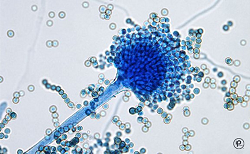Lecture Overview
In his first lecture, Dustin explains that adaptive immunity allows an individual to specifically recognize and respond to a vast number of molecules. B cells recognize intact antigens and produce neutralizing antibodies. T cells, on the other hand, have receptors on their surface that recognize very small antigen fragments bound to MHC on the surface of antigen presenting cells (APC). Dustin explains that T cells overcome the challenges of finding and binding to the APCs with the help of a multitude of adhesion molecules. Once the T cell receptor has bound a peptide antigen, an immunological synapse, with its typical bulls-eye structure, is formed resulting in T cell activation.
In Part 2, Dustin describes how a reconstituted system has allowed the immunological synapse to be studied in molecular detail. It is possible to visualize the localization of signaling molecules such as kinases, and determine the role of the actin cytoskeleton in regulating this localization. Dustin also touches on the role of the immunological synapse in autoimmune disease and cancer.
In his last lecture, Dustin presents work from his lab showing that T cell receptor enriched vesicles are generated in the immunological synapse. These vesicles can be transferred to B cells leading to activation of the B cells and, potentially, the production of higher specificity antibodies.
Speaker Bio
Michael Dustin is Professor of Immunology and Director of Research at The Kennedy Institute of Rheumatology at the University of Oxford. Prior to joining the Kennedy Institute, Dustin was a faculty member at the Skirball Institute of Biomolecular Medicine at New York University from 2001-2013 and at Washington University School of Medicine from 1993-2000. Dustin received his BA in Biology from Boston University and his PhD in Cell and Developmental Biology from Harvard University.
As described in his iBioSeminar, Dustin’s lab studies the molecular events that take place at the immunological synapse. Future research will focus on developing therapies targeted to the immunological synapse to cure chronic inflammatory illnesses such as rheumatoid arthritis.
Dustin is an active participant in the immunology community; he is a member of numerous grant review committees and journal editorial boards. His research has been recognized with many awards including the 2000 Presidential Early Career Award in Science and Engineering and the 2012 DART-NYU Biotechnology Achievement Award.
Medical and Patient education videos
-
Title
Description
-

I have Sarcoidosis, Chronic Pulmonary Aspergillosis (CPA) and a very low CD4 count. I have challenged myself to do a daily vlog for 30 days
Follow me on twitter @StewArmstrong
Here is the link for all of the monthly aspergillosis meetings http://www.nacpatients.org.uk/monthly…
This meeting was for July 2016.
Aspergillus Website: Follow all of our Youtube collections here
-

Stewart Armstrong has chronic pulmonary aspergillosis and has undertaken to record a video of every day of his life for a month in order to help raise awareness of aspergillosis and how it impacts their daily lives.
These videos are interesting for a number of reasons – not least because patients often say that they don’t look unwell so many people don’t understand how serious aspergillosis is. Does Stewart look or act unwell?
See the month of vlogs in the playlist below, or go to Stewart’s YouTube page to watch more of his videos.
-

Global fungal killers and life-threatening infections
Fungi are everywhere, and a few species can cause very serious lethal infections. Fungal infections
-

This panel considers and debates one of the greatest obstacles to food security in many parts of the world: mycotoxin. Aflatoxin is a particularly dangerous mycotoxin produced predominantly by two Aspergillus fungi. It colonizes a variety of important food and feed crops both pre- and post-harvest, including groundnuts, tree nuts, maize, rice, figs and other dried foods, spices, crude vegetable oils and cocoa. Contaminated crops have significant health risks for both humans and animals, having been linked to retarded growth and development (stunting), immunosuppression and liver cancer. The aflatoxin issue has other, complex implications for food security and, by limiting farmers’ access to international markets, can lead to food waste and economic instability.
Panelists:
-John Lamb, Principal Associate, Abt Associates
-Dr. Kitty Cardwell, National Program Leader, USDA-NIFA
-Barbara Stinson, Senior Partner, Meridian Institute; Project Director, Partnership for Aflatoxin Control in Africa
-Moderator: Dr. Howard-Yana Shapiro, Chief Agricultural Officer, Mars, Incorporated -

The role of poorly maintained ventilation ductwork in spreading airborne infections is largely ignored because it is ‘out of sight out of mind’, but recent analysis by healthcare professionals confirms that the risks are increasing.
Ghasson Shabha will identify particular threats in healthcare facilities from dirty ductwork. He also points out that fewer than 5% of building air-conditioning systems have been inspected despite regulations making this mandatory. Dr Shabha will look at how planned cleaning strategies can reduce risks and how hospitals can use 3D building information modelling software to identify ‘infection hotspots’.
The healthcare environment can be described as a reservoir for potentially infective agents which can spread unpredictably in a whole array of ways particularly in ventilation and air-conditioning systems making it difficult to effectively control and manage, for those seeking timely information about the patterns of cross-infection. The severity of the problem has been highlighted extensively over the past decade, as part of wider umbrella of what was known as health care acquired infections (HCAIs). Airborne transmission extends over a wide spectrum, and includes many prevalent agents, inter alia Mycobacterium tuberculosis (TB),nosocomial MRSA, Aspergillus fumigatus, Serratia marcescens, norovirus, and other airborne infection.
Dr Shabha was speaking live from Birmingham and this CIBSE ASHRAE Group (cibseashrae.org) webinar was co-sponsored by the B&ES Ventilation Hygiene Group and the Institute of Healthcare Engineering and Estate Management (IHEEM).
-

Oliphant Science Awards – Year 1 project by Haruki Kurioka, Aleksa Novakovic and Bogdan Novakovic (St Andrew’s Primary School, Adelaide)
Food that we consume daily is rich in good bacteria and fungi. Yogurt, Yakult and Natto (fermented soybeans) are rich in bacteria. Cheeses (e.g. Brie & Blue cheese) and Koji contain fungi Penicillium and Aspergillus, respectively. Many Japanese and continental seasonings and dishes can be prepared with those products. Many kids and their parents don’t know much about good bacteria and fungi. First year students are here to tell us their story. Enjoy it!




